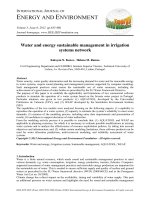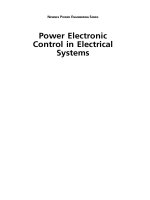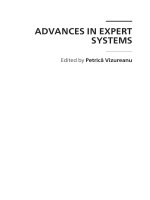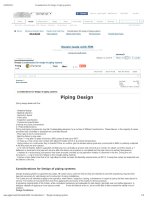Erosion-in-Piping-Systems
Bạn đang xem bản rút gọn của tài liệu. Xem và tải ngay bản đầy đủ của tài liệu tại đây (3.24 MB, 222 trang )
Computer-Based Training Module:
Erosion In Piping Systems
October 2006
Effective December 6, 2006, this report has been made publicly available in accordance
with Section 734.3(b)(3) and published in accordance with Section 734.7 of the U.S.
Export Administration Regulations. As a result of this publication, this report is subject
to only copyright protection and does not require any license agreement from EPRI.
This notice supersedes the export control restrictions and any proprietary licensed
material notices embedded in the document prior to publication.
Introduction to Navigation
Module can be navigated in a linear fashion
± Click Page Down or Enter.
By following hyperlinks for more information
± The file must be viewed in ³Slide Show´ mode for the hyperlinks to
work
± Click on a hyperlink to go directly to related information in the
training, clicking page down or enter will take you back to where
you left off.
Click on the camera picture to view a related photograph, page down,
or enter will return to the original page.
© 2006 Electric Power Research Institute, Inc. All rights reserved.
2
Introduction
Mechanical damage is commonly found in piping
systems.
There are various mechanisms possible.
They are normally combined under the category of
³erosion´ or ³erosive damage.´
© 2006 Electric Power Research Institute, Inc. All rights reserved.
3
Examples of Erosive Damage
Pump impellor
damaged by
cavitation.
© 2006 Electric Power Research Institute, Inc. All rights reserved.
Turbine blades
damaged by solid
particle erosion.
4
Purpose
This module will:
Introduce the subject
Describe the four common mechanisms that cause
damage in piping systems
Discuss how these mechanisms cause damage, and
Describe where damage is typically found.
© 2006 Electric Power Research Institute, Inc. All rights reserved.
5
Purpose - Continued
Discuss inspection approaches, materials and
countermeasures.
This module will not treat damage in machinery, e.g.,
pumps, steam turbines.
A short quiz is provided at the end of this module.
© 2006 Electric Power Research Institute, Inc. All rights reserved.
6
Erosion - Description
Erosion is the damage of materials caused by physical
processes such as high-speed, impinging flows or
solid impacts on the surface.
This is contrasted to corrosion which involves a
chemical or electrochemical process.
For more information on corrosion ± go to corrosion.
© 2006 Electric Power Research Institute, Inc. All rights reserved.
7
Erosion ± Description - Continued
Erosion occurs in a variety of power-plant
systems ± see sample photographs.
To successfully manage problems caused by
erosion, the cause of the damage must be
identified as there may be substantial
differences between mechanisms.
© 2006 Electric Power Research Institute, Inc. All rights reserved.
8
Erosion Mechanisms
The four most common erosion mechanisms in power
plants are:
± Cavitation erosion
± Flashing erosion
± Droplet impingement
± Solid particle erosion
These will be introduced
© 2006 Electric Power Research Institute, Inc. All rights reserved.
9
Photographs of Damage
Cavitation Erosion
Flashing Erosion
photo courtesy of Florida Power & Light
Droplet Impingement
Solid Particle Erosion
photo courtesy of EDF
© 2006 Electric Power Research Institute, Inc. All rights reserved.
photo courtesy of Bruce Power
10
Summary Table
Cavitation
Erosion
Flashing
Erosion
Droplet
Impingement
Solid Particle
Erosion
Fluid
Conditions
Water
Water U/S 2phase D/S
Two-Phase
Single or two
phase
Surface
Very rough
Smooth ±
polished
Very rough
Variable
Noise Vibration
Yes
Yes
No
No
Damage rate
Non-linear
Non-linear
Non-linear
Linear
D/S = Downstream
U/S = Upstream
© 2006 Electric Power Research Institute, Inc. All rights reserved.
11
Types of Erosion Damage
For more information:
Cavitation erosion -- see
Flashing erosion -- see
Liquid droplet impingement -- see
Solid particle erosion -- see.
© 2006 Electric Power Research Institute, Inc. All rights reserved.
12
Other Related Mechanisms
There are other types of damage that may be
experienced:
± Corrosion and erosion may occur simultaneous
(see next slide)
± Erosive effects may also be combined
± Other erosion mechanisms.
© 2006 Electric Power Research Institute, Inc. All rights reserved.
13
Photograph of Corrosion and Erosion Damage
Elbow Damaged by Erosion and FAC
photo courtesy of Public Service Electric & Gas
© 2006 Electric Power Research Institute, Inc. All rights reserved.
14
Other Erosion Mechanisms
Wire drawing ± high speed liquid flow normally
encountered in valve internals.
Steam cutting ± high speed steam flow normally
occurring in valve seats or when leaks occur in heat
exchangers.
© 2006 Electric Power Research Institute, Inc. All rights reserved.
15
Photographs of Damage Caused by Steam
Cutting
Steam cutting in a flange
Steam cutting in a steam trap body
© 2006 Electric Power Research Institute, Inc. All rights reserved.
16
For More Information
CHUG website
± User experience
± Past presentations on erosion.
EPRI Report 1011231.
EPRI Report TR-108943-V2.
© 2006 Electric Power Research Institute, Inc. All rights reserved.
17
Quiz
Question 1
Droplet impingement and solid particle erosion are similar
in many ways.
True
False
Question 2
There are materials that are more resistant to cavitation
erosion than carbon steel.
True
False
© 2006 Electric Power Research Institute, Inc. All rights reserved.
18
Quiz - Continued
Question 3
In order for cavitation to occur the downstream pressure
must be less than the local vapor pressure.
True
False
Question 4
In order for flashing to occur the downstream pressure
must be less than the local vapor pressure.
True
False
© 2006 Electric Power Research Institute, Inc. All rights reserved.
19
Quiz - Continued
Question 5
Data sets are available to describe cavitation in:
a) Valves
b) Orifices
c) Valves and orifices
d) Elbows
e) Nearly every situation
Question 6
Models to calculate the rate of droplet impingement are
commonly used to determine susceptibility of components
in piping systems.
True
False
© 2006 Electric Power Research Institute, Inc. All rights reserved.
20
Quiz - Continued
Question 7
Flashing erosion and droplet impingement often occur in high
pressure drop situations.
True
False
Question 8
Solid particle erosion has been found to have
a) A damage rate that is linear with time.
b) A damage rate that varies linearly with velocity
c) A damage rate that is independent of the particle size
d) A well understood damage mechanism
e) All of the above
© 2006 Electric Power Research Institute, Inc. All rights reserved.
21
Quiz - Continued
Question 9
Noise and vibration associated with a valve indicate that
cavitation erosion is occurring.
True
False
Question 10
The critical velocity for damage caused by droplet
impingement is much greater than the critical velocity for
solid particle erosion.
True
False
© 2006 Electric Power Research Institute, Inc. All rights reserved.
22
Training Complete!
© 2006 Electric Power Research Institute, Inc. All rights reserved.
23
1 - True
While droplet impingement and solid particle erosion are
both mechanical damage mechanisms, they differ in more
ways than they are similar.
Please try again.
© 2006 Electric Power Research Institute, Inc. All rights reserved.
24
1 - False
Correct! Droplet impingement and solid particle erosion
differ in many ways including material response and
velocity dependence.
Return to quiz.
© 2006 Electric Power Research Institute, Inc. All rights reserved.
25









